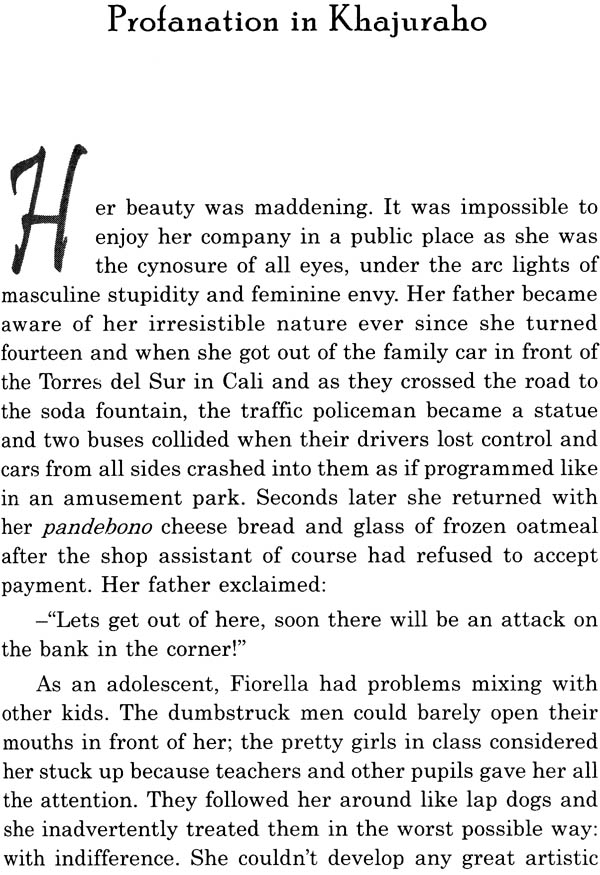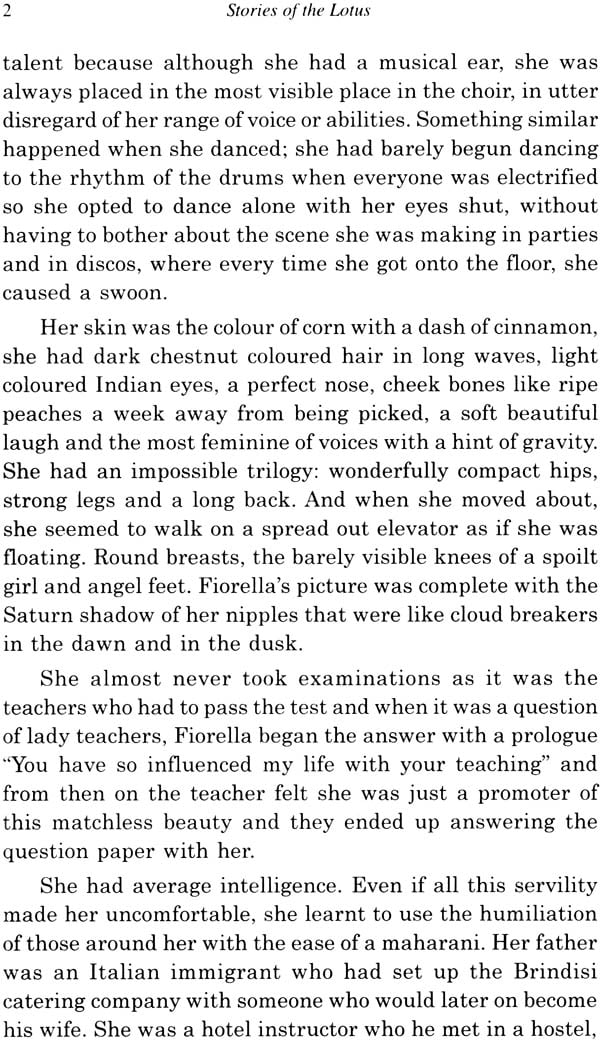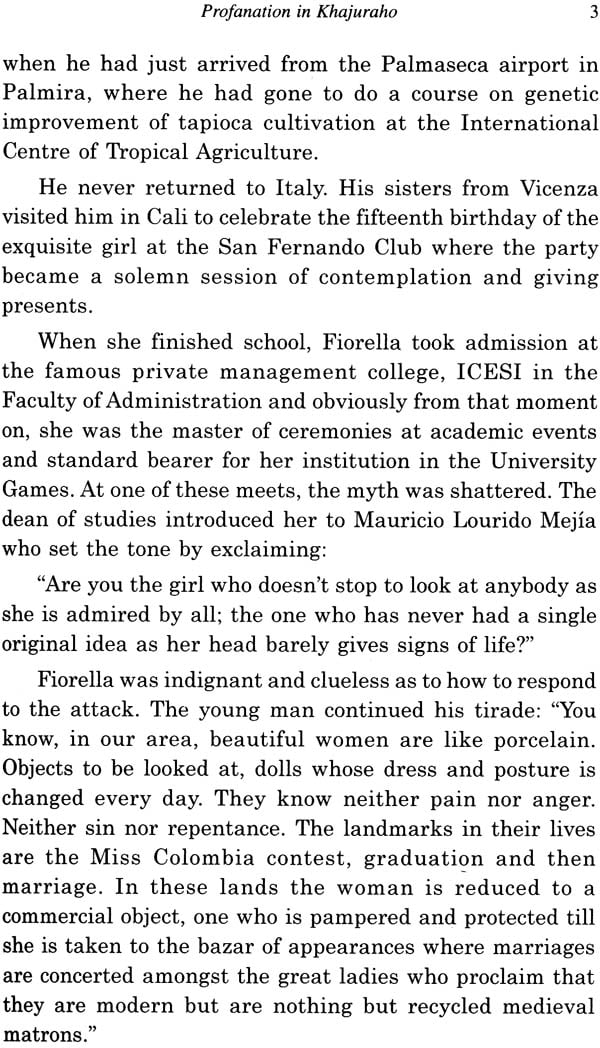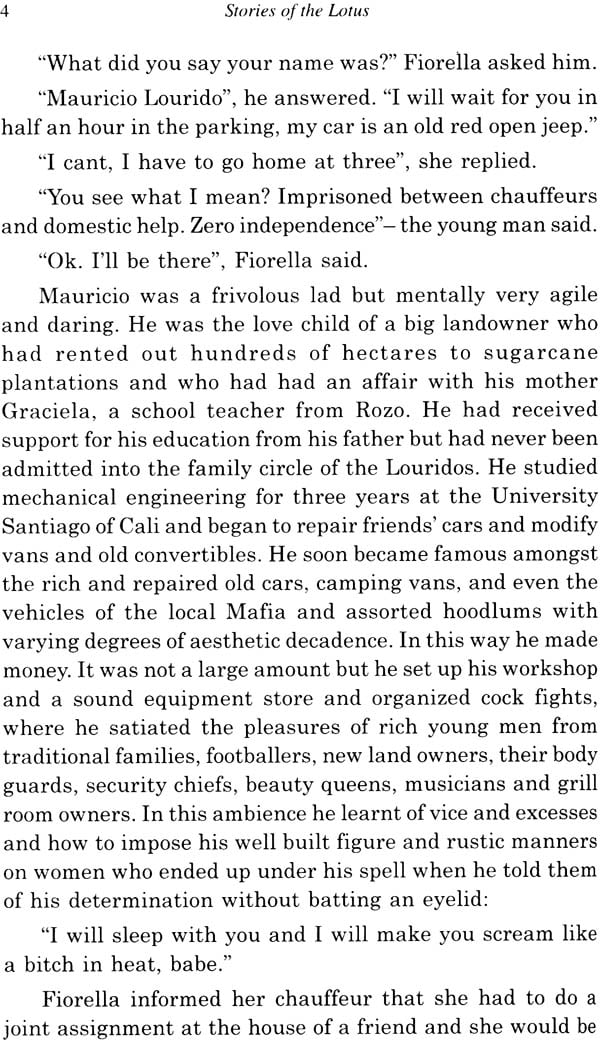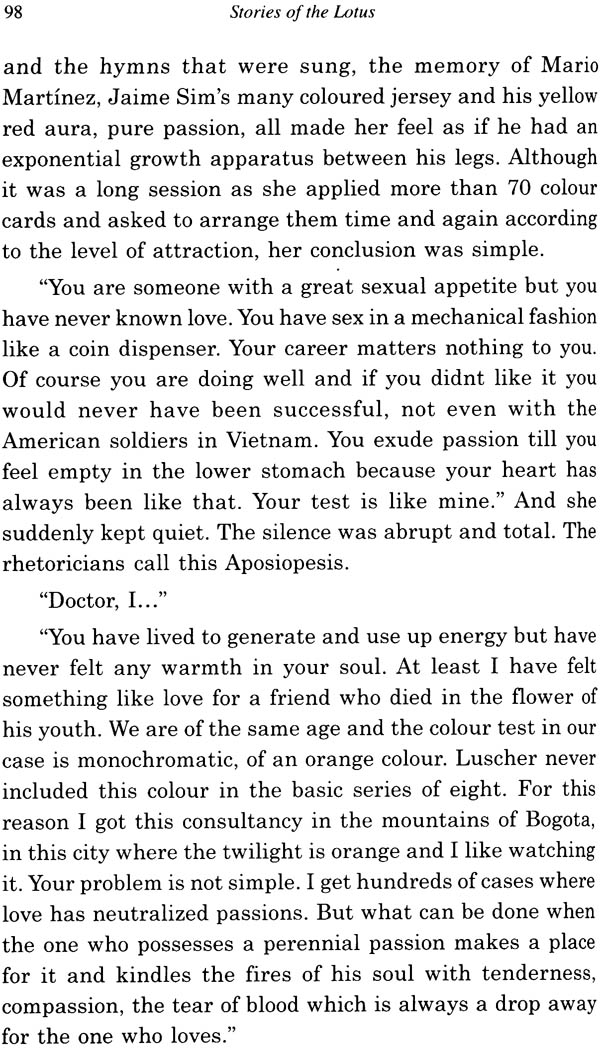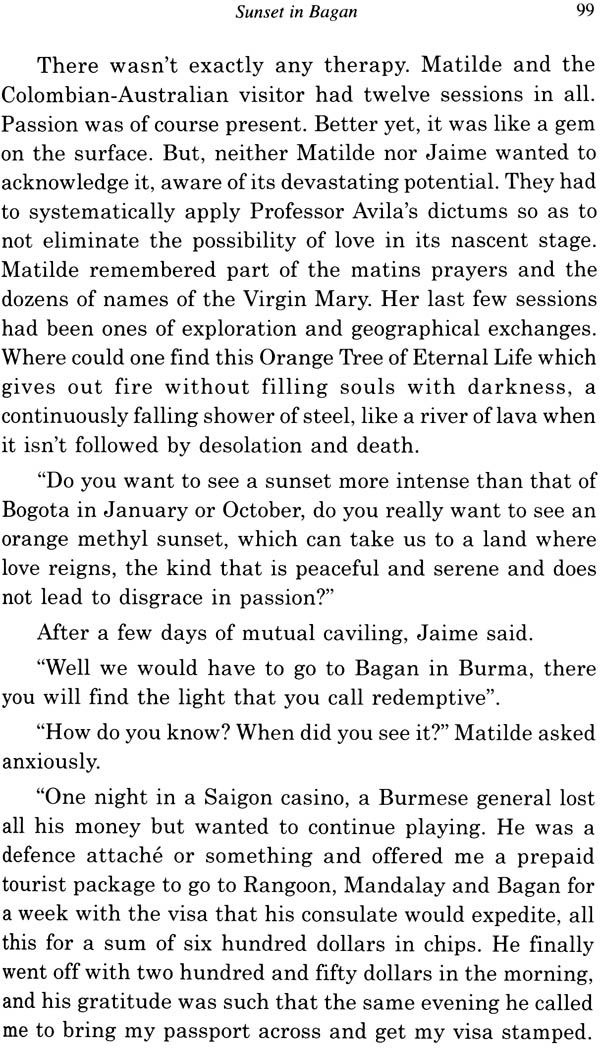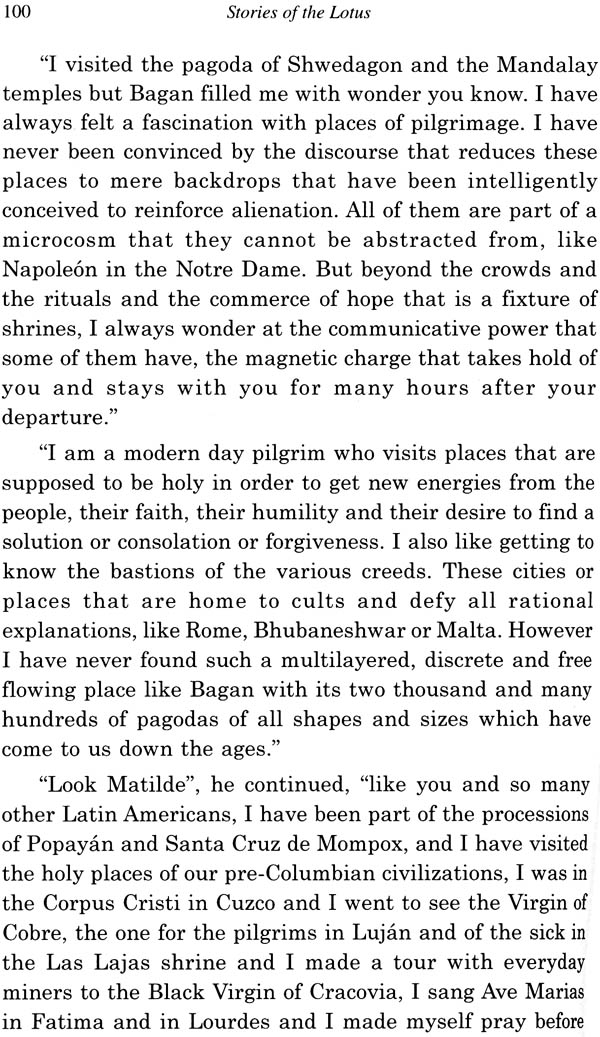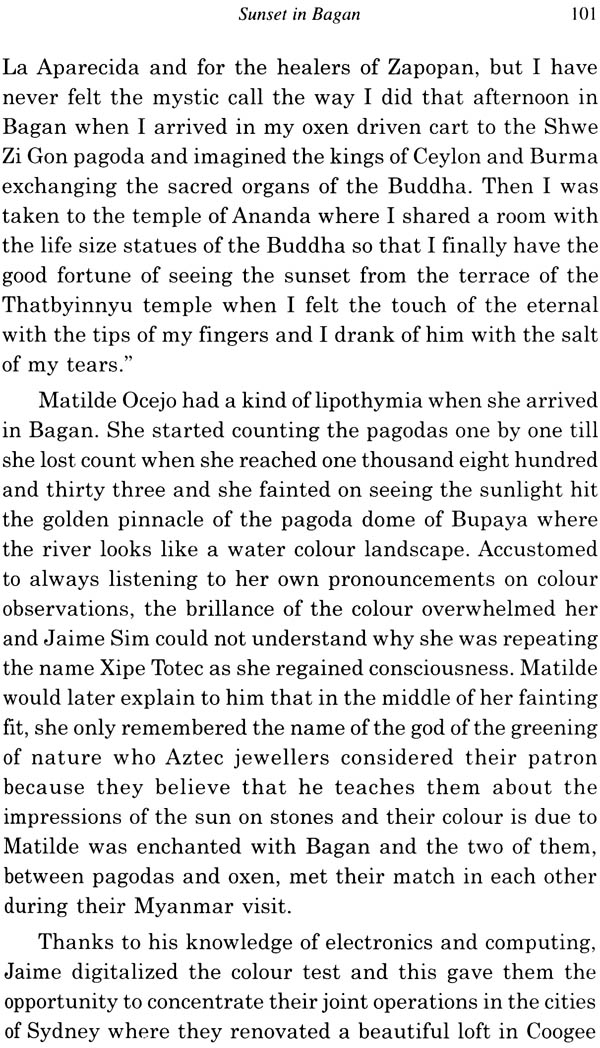
Stories of the Lotus
Book Specification
| Item Code: | NAF509 |
| Author: | Minni Sawhney |
| Publisher: | Sahitya Akademi, Delhi |
| Language: | English |
| Edition: | 2011 |
| ISBN: | 9788126029518 |
| Pages: | 122 (10 Color Illustrations) |
| Cover: | Paperback |
| Other Details | 8.5 Inch x 5.5 Inch |
| Weight | 230 gm |
Book Description
During his sojourns his sojourns in various countries in Asia where his work took him, Juan Alfredo Pinto Saavedra, accumulated vivid and valued experience which are depicted in the collection of ten short stories fist published in Spanish. His passion and love for Asia are evident in the stories that related to several places in Asia be it the caves of Eldora, a temple at Sri Lanka, the Buddhist shrines at Myanmar, or the endless march of great variety of humankind in Singapore, Kolkata and Bangkok. The plight of the contemporary man caught between moral, economic and technogical tensions is portrayed with immense subtlety and a rare philosophical depth.
Juan Alfredo Pinto Saavedra
Juan affredo pinto Saavedra was born in 1953 in Girardot, a place near Bogota, Colombia. A Graduate in Economics and Agricultural Business Administration, he has also worked as a columnist in some of the leading newspapers in Colombia besides books such as Globalization Para Todos (2006), Pon Una Economic Social y Ecological de Mercado (19992) etc. He is also a recipient of the Merit Order of Bogota and the Order of the Industrial Merit besides the Ciudaenia de honour in several Columbian and Latin American cities. Currently he is the Ambassador of Colombia to India.
Minni Sawhney
Minni Sawhney teaches Spanisha t the university of Delhi. She has translated parts of Mexico India encuentros similitudes traves de la historia in 1996 for the Fondo de culture Economica in Mexico City and the Mexican novel El ojo de los dioses by Grazietta salcedo. For the past two years she has also been translating vislumbres the literary journal of the Spanish embassy in India.
Asia is extremely fascinating, with its exotic landscapes and amazing rituals, its seductive fragrances and food, its colorful dresses and extraordinary-coordinated movements. It has a seductive magic, the age old fascination when one observes the world slowly in all its profusion, like an endless spectacle that unfolds speechlessly before our eyes; the very spectacle of life.
The way of life in this diverse continent is impressive. Linked intrinsically to the earth, the ancestral practices and sensual customs that these numerous and ancient people have minutely constructed go far beyond the ordinary and overwhelm the visitor. In an ineluctable manner, everything is disturbing and at the same time amazing: existence as well as the passage of time and the way things come to pass here.
The mysteries of the caves at Ellora, the temples of Sri Lanka, the marvelous Buddhist shrines of Bagan in Myanmar, the endless march of a great variety of humankind in Singapore or Malaysia, Calcutta or Bangkok are not only some of the onerous experiences of travel; this inexhaustible energy that overflows the boundless river of life, this force that feeds from the spectator and the observer, and yet, warm and receptive, includes and protects each one, enveloping him in its sweet balsam.
Experience shows that Asia knows about tolerance and diversity, because even though it is a cluster of societies very different from each other, lacerated by bitter destiny, yet there is coexistence and cohabitation, an adaptation that has been almost always gentle, and people, worlds, and visions of things that have nothing apparently in common are brought together. Differences exist, and they are delineated with lucid clarity, but these boundaries in the soul are not an obstacle to fluid reconciliation. This is the multi-hued setting of the book Stories of the Lotus. The Latin American protagonists therein, moved by varying reasons and motives, travel and are strongly impacted but nevertheless also taken in by the gentleness leaving in this way the trace of Asia on them, on their being, on their journeys, on their destinies.
This huge land mass is the space where more than half of humanity lives. It is a group of countries where for thousands of years, populous, powerful and colorful societies have flourished. They have been kindled by an internal fire that slowly consumes them but also at the same time warms them, and fills them with life, grace and freshness. Women walking down country roads, the chants of the farmers, the sinuous and delicious treat of having to adapt to a world whose astounding features you can never exhaust, a world that veils a part of itself out of discretion or shyness, and is thus considered imbued with mystery, this is deep Asia, south Asia, southeast Asia with its monsoons, its grace, its rain, its sun, its forests, its deserts. This world that has so much to give us does not seem to give much more than the miracle of mere existence, it does not make itself out to be a paradise and yet it is possible to find one here if one observes everything with the same innocence and with the same energy and grandeur with which people make their own paradise.
The stories of Juan Alfredo Pinto feed on these cross currents. The observations are sharp and keen eyes note not only what happens here, but what happens to us here, to those of us who have been born on the confluence of the West and other worlds, also alive with colour and tension. From this fount the waters of deep aesthetic contemplation flow, a subtle emanation, mystical or worldly, and its characteristics have been a constant source of interpretation for Western travellers. It is in this game, in this powerful horizon, that it is possible to get a glimpse of Asia and allow her to give a glimpse of herself. From here, none of the characters that Juan Alfredo Pinto describes in his stories returns intact, unblemished. The mark of the places he passed through, the things he has seen, the people who met and spoke to him, what he lived and ate, what he felt have inevitably left a trace on him. It is the reflection of some implacable tour de force, that has swept away pain and desperation to another shore carried away by other currents.
As a sober and well meaning observer, the author understands and makes others understand that Asia is humanity. It is here that the wheels of the great engine of life slowly revolve, and it is here that the paths of future humanity are navigated and lived for thousands of years, when people navigated or were carried by oxen on its roads. They thronged its seas, its rivers and lakes, its holy places and thousands and millions of temples. It is of course a common place to talk of spirituality in Asia and unfortunately in many cases it has become a cliché but if that daily shared strong sentiment is not spirituality, then what is it?
One has-to start from this premise and thus contemplate our own lands, our own skies, look at them with fresh eyes and find a new dimension to all that we have here in the palm of our hands, so that our water tastes even better and our skies and rain continue to enchant us. We have to learn how to compare our visions and it is not Europe, a Europe that is relatively spent and decrepit, and at times full of pain that can give us these lessons, it is Asia with its multitudes and its miseries, its feats, its incredible material poverty, its striking simplicity and its sublime serenity when it comes to finding the manner in which it is possible to enjoy the world.
This expertly written book of short stories has portrayed us Latin Americans, peripherals or borderline Westerners with magnificent precision. We are at times gazing at Asia with innocent eyes, or roaming about aimlessly, or evoking extraordinary sensations. Juan Alfredo's book Stories of the Lotus is a magnificent tool for interpreting the different worlds that cohabit in this gallery of universes, from the vantage point of our prosaic reality. In this array of daily encounters, the impassioned traveller reaches the limits of the sublime.
Full of subtle flavours, many of them hidden, others grandiose, we can embark on delicate journeys towards sweet mysteries. They are delicate and discrete in their purest essence and make up the Asia of yesteryear, the Asia of today and the everlasting Asia. To discover all this, or perhaps to gaze at it with affection and joy, to recognize it, visit it with eyes really wide open, with all of one's senses, is an alternative, a horizon, a possibility. That expectedly turn our eyes towards all efforts made for an authentic or perhaps an eternal humanity. A humanity which is theirs and in some measure we all carryon our shoulders and which is still possible to maintain in the twenty-first century.
| Prologue | vii |
| Acknowledgement | xi |
| Profanation in Khajuraho | 1 |
| Nisansala | 17 |
| Tetrahedron | 26 |
| The Straw Maker of Rudimental | 38 |
| The Clue Beneath Your Feet | 47 |
| Jose Gregorio | 59 |
| diptychs of Piety | 69 |
| The Melting Pot | 82 |
| Sunset in Began | 92 |
| Majira | 103 |
